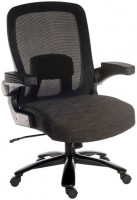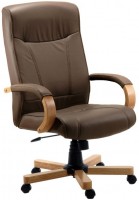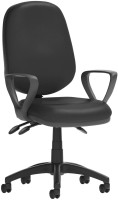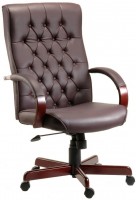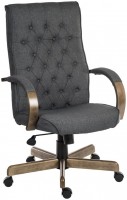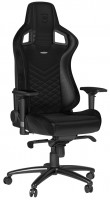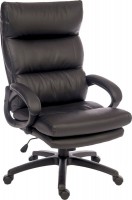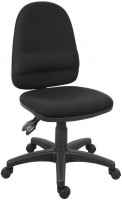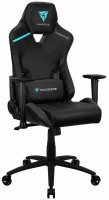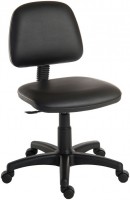Computer Chairs Arozzi
All Computer Chairs Advanced filters → |
You might be interested in
Articles, reviews, useful tips
All materials
How to choose computer chair
What to consider when choosing comfortable computer chair for height and other factors

Сomputer chairs swing mechanisms overview: pros and cons of each type
What are the swing mechanisms in computer and office chairs

Transparent TV, 3D laptop, interior speaker and other interesting announcements from CES 2024
Here's a look at the most interesting electronics innovations from the largest international exhibition CES 2024

5 gaming chairs for dedicated gamers
If you sit at the computer for hours, then it is better to do it with maximum comfort

Differences between gaming, regular and orthopedic chair
What is the difference between gaming chair and regular one? And what kind of «beast» is orthopedic model?
Computer Chairs: specifications, types
Show all
Features
— For the leader. The "director's" chair is designed not only to provide comfort to the leader, but also to emphasize his status and authority. Therefore, such models usually have a massive structure and larger dimensions than conventional chairs for staff, and also use more expensive materials (primarily leather and its analogues) — which ensures an appropriate solid design. Many executive chairs also have a specific shape with a slightly "failed" seat, headrests, etc.; all this is designed to increase the comfort of the seated.
— For staff. Armchairs designed primarily for ordinary office workers. On the practical side, for the most part, they are less comfortable than executive models — in particular, they are rarely equipped with head restraints (see below) and lumbar support. At the same time, the key difference lies in the fact that in this case the emphasis is not on design, but on practicality. So, the design uses mainly inexpensive, but sufficiently durable materials (fabric, mesh, etc.), the weight of the chairs is small, which makes it easy to move them from place to place, and the shape of the seat and armrests is usually chosen in such a way that It was convenient for the seated person to get up and sit down often. However, models for staff are sometimes so good and functional that they can be safely attributed to managerial chairs, so such options can have a dual purpose — for the ma...nager and staff.
— For visitors. The specificity of chairs of this type is that they, usually, are constantly in one place, while they are used by different people who have to sit for a relatively short time. Therefore, such models most often have bases in the form of legs or skids (see "Base design"), and their design as a whole is quite simple and rarely provides any additional adjustments. Nevertheless, in this class there are both simple products made of inexpensive materials that provide a minimum of comfort, and very solid-looking furniture, designed for richly furnished offices and not inferior in quality to the "director's" chairs.
— Children's. Armchairs designed for children have appropriate design features — reduced dimensions and a specific shape of the seat and back. In addition, among such models there are options in a rather bright original design — with colour drawings, an unusual shape of the backs and seats, etc.
— Gamer. Models created specifically for gamers stand out with a characteristic "aggressive" design, hinting at the seats of racers and pilots. However, they are often as comfortable as real racing seats, and the equipment includes at least a Tilt mechanism, and more often a more advanced solution such as a multiblock or synchro mechanism (see above). In general, this is a fairly advanced type of chair — but not cheap, respectively.
— For staff. Armchairs designed primarily for ordinary office workers. On the practical side, for the most part, they are less comfortable than executive models — in particular, they are rarely equipped with head restraints (see below) and lumbar support. At the same time, the key difference lies in the fact that in this case the emphasis is not on design, but on practicality. So, the design uses mainly inexpensive, but sufficiently durable materials (fabric, mesh, etc.), the weight of the chairs is small, which makes it easy to move them from place to place, and the shape of the seat and armrests is usually chosen in such a way that It was convenient for the seated person to get up and sit down often. However, models for staff are sometimes so good and functional that they can be safely attributed to managerial chairs, so such options can have a dual purpose — for the ma...nager and staff.
— For visitors. The specificity of chairs of this type is that they, usually, are constantly in one place, while they are used by different people who have to sit for a relatively short time. Therefore, such models most often have bases in the form of legs or skids (see "Base design"), and their design as a whole is quite simple and rarely provides any additional adjustments. Nevertheless, in this class there are both simple products made of inexpensive materials that provide a minimum of comfort, and very solid-looking furniture, designed for richly furnished offices and not inferior in quality to the "director's" chairs.
— Children's. Armchairs designed for children have appropriate design features — reduced dimensions and a specific shape of the seat and back. In addition, among such models there are options in a rather bright original design — with colour drawings, an unusual shape of the backs and seats, etc.
— Gamer. Models created specifically for gamers stand out with a characteristic "aggressive" design, hinting at the seats of racers and pilots. However, they are often as comfortable as real racing seats, and the equipment includes at least a Tilt mechanism, and more often a more advanced solution such as a multiblock or synchro mechanism (see above). In general, this is a fairly advanced type of chair — but not cheap, respectively.
Max. user weight
The highest weight that the chair is guaranteed to withstand with regular use — in other words, the maximum weight of a seated person, allowing you to constantly use the product in normal mode without fear of unexpected breakdown. Note that many models are able to endure short-term excess weight without problems, however, anyway, it is not worth overloading the structure (and even more so doing it all the time): off-design loads will significantly increase its wear, and breakdown can occur at the most unexpected moment.
Back height
Высота спинки кресла; для моделей с изменяемой высотой спинки, как правило, указывается максимальное значение.
Высота спинки измеряется от сидения до верхнего края. По сути, это высота опоры, доступной для спины. В некоторых ситуациях на этот показатель можно не обращать особого внимания — например, если кресло предназначается для посетителей и роль спинки в нем чисто символическая. Однако если сидеть в кресле предстоит часто и подолгу — стоит учесть и этот момент. В идеале лучше всего попробовать «вживую» несколько кресел и выяснить, какая высота спинки для вас является наиболее комфортной. Если же такой возможности нет — стоит решить, до какой области на теле должна доставать спинка (до лопаток, до основания шеи и т. п.) и замерить, на какой высоте от сидения находится эта область в сидячем положении. А если вам нужна конкретно опора для затылка — стоит выбирать среди моделей, оснащенных подголовниками.
Спинка считается высокой, если она имеет высоту не менее 65 см. Благодаря таким размерам кресло обеспечивает опору практически на всю спину сидящего человека, а нередко — еще и на затылок. В то же время стоит учитывать, что далеко не всякая высокая спинка является подголовником.
Высота спинки измеряется от сидения до верхнего края. По сути, это высота опоры, доступной для спины. В некоторых ситуациях на этот показатель можно не обращать особого внимания — например, если кресло предназначается для посетителей и роль спинки в нем чисто символическая. Однако если сидеть в кресле предстоит часто и подолгу — стоит учесть и этот момент. В идеале лучше всего попробовать «вживую» несколько кресел и выяснить, какая высота спинки для вас является наиболее комфортной. Если же такой возможности нет — стоит решить, до какой области на теле должна доставать спинка (до лопаток, до основания шеи и т. п.) и замерить, на какой высоте от сидения находится эта область в сидячем положении. А если вам нужна конкретно опора для затылка — стоит выбирать среди моделей, оснащенных подголовниками.
Спинка считается высокой, если она имеет высоту не менее 65 см. Благодаря таким размерам кресло обеспечивает опору практически на всю спину сидящего человека, а нередко — еще и на затылок. В то же время стоит учитывать, что далеко не всякая высокая спинка является подголовником.
Shoulder back width
The width of the back at the shoulders of the intended wearer.
In order to recline as much as possible on the back, this width should be no less than the actual width of the user's shoulders. At the same time, for more or less comfortable use, a smaller back size is also sufficient — approximately corresponding to the width of the back in the area of \u200b\u200bthe shoulders (between the outer edges of the shoulder blades). Well, anyway, this parameter is, on the one hand, secondary, and on the other, very subjective. This means that in most cases you can not pay much attention to it, however, if you have already decided to choose the furniture that is the most suitable in size, it is better not to measure your own back, but to test several chairs and determine the most convenient value by experience.
In order to recline as much as possible on the back, this width should be no less than the actual width of the user's shoulders. At the same time, for more or less comfortable use, a smaller back size is also sufficient — approximately corresponding to the width of the back in the area of \u200b\u200bthe shoulders (between the outer edges of the shoulder blades). Well, anyway, this parameter is, on the one hand, secondary, and on the other, very subjective. This means that in most cases you can not pay much attention to it, however, if you have already decided to choose the furniture that is the most suitable in size, it is better not to measure your own back, but to test several chairs and determine the most convenient value by experience.
Seat size (WxD)
Dimensions of the seat installed in the chair in width and depth (from the back to the front edge). For models with variable depth (see "Adjustments"), the maximum value is taken into account when the seat is pushed forward to the stop.
Most modern chairs are designed for the average adult, so paying attention to size is primarily for people of a large, or, conversely, miniature physique. In width, the average is considered to be 45 – 55 cm, the narrowest models are up to 40 cm wide, in the widest it can exceed 60 cm. Similarly, a depth of less than 40 cm is considered small, up to 60 cm — medium, more than 60 cm — large.
Most modern chairs are designed for the average adult, so paying attention to size is primarily for people of a large, or, conversely, miniature physique. In width, the average is considered to be 45 – 55 cm, the narrowest models are up to 40 cm wide, in the widest it can exceed 60 cm. Similarly, a depth of less than 40 cm is considered small, up to 60 cm — medium, more than 60 cm — large.
Seat height
Seat height from the floor. The optimal height for a person of average height is considered to be 40 – 50 cm, however, this moment is largely subjective, and the comfort of the chair for a particular user depends heavily on his preferences and physique. Thus, many models have the ability to change the height in a certain range (see "Adjustments"). To choose, it is best to determine “live” at what height you are comfortable sitting, and find a model with the appropriate characteristics.
Base
The type of support on which the chair is placed.
— Cross with rollers. A structure in the form of several horizontal supports extending from one point in different directions. Such supports are usually provided for at least 5 — this prevents the chair from tipping over; a vertical bar rests on the point of their connection, on which the seat is located, and a transport roller (wheel) is installed at the end of each support. Armchairs with such bases are extremely convenient to move — the rollers make it easy to roll them. On the other hand, mobility requires some caution, and in some cases it is simply inappropriate.
— Legs. Classic legs similar to those used in ordinary home chairs. Unlike the cross, they are not equipped with rollers, and in order to move such a chair, it is necessary to raise it entirely. However, this cannot be called a disadvantage — in some cases (for example, in chairs for visitors, see "Intended use"), a stable installation and the inability to accidentally move the product are an advantage. Of any significant shortcomings, one can only name the tendency of the legs to push through the pressure-sensitive coating on the floor over time.
— Skids. Like the legs described above, such bases are not designed for frequent movement and are used in chairs designed to stay in one place all the time — primarily in models for visito...rs (see "Intended Use"). Usually the skids are a kind of frame — a rectangle without one side, on which the whole structure rests. This shape not only provides an original appearance, but also has less effect on the floor than classic legs: the runners have a larger area of contact with the support, due to which they create less pressure.
— Cross with rollers. A structure in the form of several horizontal supports extending from one point in different directions. Such supports are usually provided for at least 5 — this prevents the chair from tipping over; a vertical bar rests on the point of their connection, on which the seat is located, and a transport roller (wheel) is installed at the end of each support. Armchairs with such bases are extremely convenient to move — the rollers make it easy to roll them. On the other hand, mobility requires some caution, and in some cases it is simply inappropriate.
— Legs. Classic legs similar to those used in ordinary home chairs. Unlike the cross, they are not equipped with rollers, and in order to move such a chair, it is necessary to raise it entirely. However, this cannot be called a disadvantage — in some cases (for example, in chairs for visitors, see "Intended use"), a stable installation and the inability to accidentally move the product are an advantage. Of any significant shortcomings, one can only name the tendency of the legs to push through the pressure-sensitive coating on the floor over time.
— Skids. Like the legs described above, such bases are not designed for frequent movement and are used in chairs designed to stay in one place all the time — primarily in models for visito...rs (see "Intended Use"). Usually the skids are a kind of frame — a rectangle without one side, on which the whole structure rests. This shape not only provides an original appearance, but also has less effect on the floor than classic legs: the runners have a larger area of contact with the support, due to which they create less pressure.
Mechanism
A type of mechanism that provides various adjustments (see below).
— Permanent contact. A mechanism designed to ensure constant contact between the back of the seated person and the back of the chair. Accordingly, the adjustments available when using it relate only to the back, but the list of such adjustments is quite extensive: in height, inclination and depth of the back. At the same time, permanent contact is found mainly in inexpensive chair models.
— Freestyle. Also known as a permanent back support mechanism. Another fairly simple option, concerning only the adjustment of the back of the chair. The back and seat in such models are connected by a flexible plastic cover, which contains a spring; due to a special screw, it is possible to change the degree of compression of the spring, thus adjusting the degree of swing stiffness.
— Tilt(swing). Also known as Top Gun. A mechanism that provides the possibility of rocking back and forth, as well as adjusting the rocking stiffness; in addition, in most cases it also provides the adjustment of the seat height according to the principle of the piastres described above. The adjustment knob is responsible for two functions — gas lift control and swing blocking; rocking stiffness is usually controlled separately. This type of mechanism involves a rigidly connected back and seat.
—...href="/list/897/pr-28623/">Deep Tilt(deep swing). A variation of the tilt mechanism (see the relevant paragraph), which, in accordance with the name, provides the possibility of a deeper swing. Simply put, in such a chair you can lean back very far, almost lie down. However the seat and backrest in such models are still rigidly connected to each other, and fixation is provided only in one position — vertical (working).
This option is typical mainly for products of the middle and higher price range.
— Freelock. Like the Tilt described above, this mechanism allows free swing and stiffness adjustment. In such chairs, however, fixation in one position is not provided — on the other hand, the backrest in them does not have a rigid connection with the seat and can be separately adjusted in height and inclination.
— Multiblock. In fact, it is an improved and supplemented version of the Tilt described above. Multiblocks not only allow you to swing and adjust the rigidity of the swing, but also provide the possibility of fixing the chair in four positions (instead of one). In addition, they are usually equipped with so-called “anti-shock effect”: when unlocking, the tilt of the chair does not change on its own, for this you need to apply a little effort. This prevents jerks and shocks to the occupant's body when the mounts are released.
— AnyFix. A kind of swing mechanism that allows you to fix the chair in any intermediate position — and not only in those specified by the manufacturer, as is the case with Tilt and multiblocks (see above). Provides maximum freedom in tilt adjustment, however, it is quite expensive.
— MultiFix. Another, along with AnyFix, is a kind of tilt mechanism that allows you to fix the chair in any intermediate position. In fact, from the point of view of the user, these mechanisms fundamentally differ only in name. Accordingly, the advantages and disadvantages of "multifixes" are the same: on the one hand, this is convenience in setting up, on the other hand, a higher cost than, for example, "tilts". Also note that the seat and back in such chairs are usually rigidly connected and lean together.
— Synchro mechanism. The name of this mechanism is due to the fact that the back and seat in it are synchronized in a special way: when swinging, they do not deviate in the same way, but in a ratio of 2:1. It is believed that this provides an anatomically optimal fit to the position of the human body when bending back. In addition, such mechanisms usually have several fixed tilt positions, rocking stiffness settings and an anti-shock system (described in detail in the “Multiblock” paragraph above). This option is considered one of the most suitable for high-quality "director's" chairs (see "Purpose").
— Asynchronous. The asynchronous mechanism assumes the presence of a back and a seat that can change the slope independently of each other; usually, both there and there several fixed provisions are provided. Such designs provide ample features for customization to individual preferences, but the customization itself is not as convenient as in most of the advanced mechanisms described above.
— Piastre. One of the simplest mechanisms, found mainly in low-cost-level models. Allows you to change only the height of the seat. The operation of the mechanism is based on the action of a gas lift — a sealed reservoir with a piston, where gas is pumped under high pressure. The gas lift is located in the support column of the chair, under the seat, and the handle is usually located on the side of this column, within reach of the person sitting, for adjustment. Pressing this knob unlocks the seat and you can adjust the chair as you wish – raise it up and let the gas lift push the seat up, or push it down and lower the height. When the handle is released, the seat is fixed in the predetermined position. Gas lifts are often used in conjunction with other options described below, and the “piastre” type includes only structures that do not have other mechanisms for adjustment — these are mainly low-cost-class chairs.
— React. Mechanism developed by Legett&Platt; React's specific feature is that it combines the rocking of the back with the movement of the seat back and forth. This, according to the creators, provides the most comfortable and at the same time natural movement of the body when swinging. Another interesting feature is that React does not require manual adjustment to the user's weight, the mechanism itself regulates the effort required for swinging. There are usually as many as 8 fixed positions. Armchairs with such a mechanism may outwardly resemble models for staff (see "Purpose") — in particular, they have a back and seat clearly separated from each other — however, with all its advantages, React is not cheap, as a result of which Still, it's more for leaders.
– Relaxing Active System. Another high-end "anatomical" movement, designed for the most comfortable and natural movement; used mainly in furniture from the company Elano. Like the React described above, it combines the swing of the back with the movement of the seat back and forth; in addition, it may also be possible to change the inclination of the headrest depending on the inclination of the backrest. At the same time, chairs with the Relaxing Active System are usually made in a solid classic design, using leather, which makes them look rich and representative, but they also cost accordingly.
— Aircraft. A variation of the rocking mechanism used primarily in AMF chairs. In chairs with this feature, the place of attachment of the seat to the stand is not located in the centre of the seat, but closer to the front edge, at the very knees. This is believed to provide additional comfort and a more natural body position than traditional binding arrangements. Otherwise, this mechanism is similar to the Tilt systems (see above).
— Double springs. A mechanism based on a twin spring that supports the back of the chair and creates impedance when the seated person leans back. The impedance of the springs can be adjusted, thus changing the angle by which the backrest will deflect under the weight of the user. This mechanism is used in some gaming chairs (see "Purpose").
— Permanent contact. A mechanism designed to ensure constant contact between the back of the seated person and the back of the chair. Accordingly, the adjustments available when using it relate only to the back, but the list of such adjustments is quite extensive: in height, inclination and depth of the back. At the same time, permanent contact is found mainly in inexpensive chair models.
— Freestyle. Also known as a permanent back support mechanism. Another fairly simple option, concerning only the adjustment of the back of the chair. The back and seat in such models are connected by a flexible plastic cover, which contains a spring; due to a special screw, it is possible to change the degree of compression of the spring, thus adjusting the degree of swing stiffness.
— Tilt(swing). Also known as Top Gun. A mechanism that provides the possibility of rocking back and forth, as well as adjusting the rocking stiffness; in addition, in most cases it also provides the adjustment of the seat height according to the principle of the piastres described above. The adjustment knob is responsible for two functions — gas lift control and swing blocking; rocking stiffness is usually controlled separately. This type of mechanism involves a rigidly connected back and seat.
—
This option is typical mainly for products of the middle and higher price range.
— Freelock. Like the Tilt described above, this mechanism allows free swing and stiffness adjustment. In such chairs, however, fixation in one position is not provided — on the other hand, the backrest in them does not have a rigid connection with the seat and can be separately adjusted in height and inclination.
— Multiblock. In fact, it is an improved and supplemented version of the Tilt described above. Multiblocks not only allow you to swing and adjust the rigidity of the swing, but also provide the possibility of fixing the chair in four positions (instead of one). In addition, they are usually equipped with so-called “anti-shock effect”: when unlocking, the tilt of the chair does not change on its own, for this you need to apply a little effort. This prevents jerks and shocks to the occupant's body when the mounts are released.
— AnyFix. A kind of swing mechanism that allows you to fix the chair in any intermediate position — and not only in those specified by the manufacturer, as is the case with Tilt and multiblocks (see above). Provides maximum freedom in tilt adjustment, however, it is quite expensive.
— MultiFix. Another, along with AnyFix, is a kind of tilt mechanism that allows you to fix the chair in any intermediate position. In fact, from the point of view of the user, these mechanisms fundamentally differ only in name. Accordingly, the advantages and disadvantages of "multifixes" are the same: on the one hand, this is convenience in setting up, on the other hand, a higher cost than, for example, "tilts". Also note that the seat and back in such chairs are usually rigidly connected and lean together.
— Synchro mechanism. The name of this mechanism is due to the fact that the back and seat in it are synchronized in a special way: when swinging, they do not deviate in the same way, but in a ratio of 2:1. It is believed that this provides an anatomically optimal fit to the position of the human body when bending back. In addition, such mechanisms usually have several fixed tilt positions, rocking stiffness settings and an anti-shock system (described in detail in the “Multiblock” paragraph above). This option is considered one of the most suitable for high-quality "director's" chairs (see "Purpose").
— Asynchronous. The asynchronous mechanism assumes the presence of a back and a seat that can change the slope independently of each other; usually, both there and there several fixed provisions are provided. Such designs provide ample features for customization to individual preferences, but the customization itself is not as convenient as in most of the advanced mechanisms described above.
— Piastre. One of the simplest mechanisms, found mainly in low-cost-level models. Allows you to change only the height of the seat. The operation of the mechanism is based on the action of a gas lift — a sealed reservoir with a piston, where gas is pumped under high pressure. The gas lift is located in the support column of the chair, under the seat, and the handle is usually located on the side of this column, within reach of the person sitting, for adjustment. Pressing this knob unlocks the seat and you can adjust the chair as you wish – raise it up and let the gas lift push the seat up, or push it down and lower the height. When the handle is released, the seat is fixed in the predetermined position. Gas lifts are often used in conjunction with other options described below, and the “piastre” type includes only structures that do not have other mechanisms for adjustment — these are mainly low-cost-class chairs.
— React. Mechanism developed by Legett&Platt; React's specific feature is that it combines the rocking of the back with the movement of the seat back and forth. This, according to the creators, provides the most comfortable and at the same time natural movement of the body when swinging. Another interesting feature is that React does not require manual adjustment to the user's weight, the mechanism itself regulates the effort required for swinging. There are usually as many as 8 fixed positions. Armchairs with such a mechanism may outwardly resemble models for staff (see "Purpose") — in particular, they have a back and seat clearly separated from each other — however, with all its advantages, React is not cheap, as a result of which Still, it's more for leaders.
– Relaxing Active System. Another high-end "anatomical" movement, designed for the most comfortable and natural movement; used mainly in furniture from the company Elano. Like the React described above, it combines the swing of the back with the movement of the seat back and forth; in addition, it may also be possible to change the inclination of the headrest depending on the inclination of the backrest. At the same time, chairs with the Relaxing Active System are usually made in a solid classic design, using leather, which makes them look rich and representative, but they also cost accordingly.
— Aircraft. A variation of the rocking mechanism used primarily in AMF chairs. In chairs with this feature, the place of attachment of the seat to the stand is not located in the centre of the seat, but closer to the front edge, at the very knees. This is believed to provide additional comfort and a more natural body position than traditional binding arrangements. Otherwise, this mechanism is similar to the Tilt systems (see above).
— Double springs. A mechanism based on a twin spring that supports the back of the chair and creates impedance when the seated person leans back. The impedance of the springs can be adjusted, thus changing the angle by which the backrest will deflect under the weight of the user. This mechanism is used in some gaming chairs (see "Purpose").
Headrest
The presence of a headrest in the design of the chair.
The role of the headrest can be played as a stand, made separately from the backrest, and the upper part of the backrest — if it has a pronounced characteristic shape or a pillow is supplied in the kit, which can be installed at the request of the user. The simplest high backs that do not have a characteristic upper part are not considered head restraints.
Anyway, this feature provides additional comfort — especially when reclining back. On the other hand, if you have to sit mostly straight in the chair and the back plays a symbolic role, perhaps the best choice would be a model without a headrest(especially since such chairs are cheaper).
The role of the headrest can be played as a stand, made separately from the backrest, and the upper part of the backrest — if it has a pronounced characteristic shape or a pillow is supplied in the kit, which can be installed at the request of the user. The simplest high backs that do not have a characteristic upper part are not considered head restraints.
Anyway, this feature provides additional comfort — especially when reclining back. On the other hand, if you have to sit mostly straight in the chair and the back plays a symbolic role, perhaps the best choice would be a model without a headrest(especially since such chairs are cheaper).
Armrests
The presence of armrests in the design of the chair — characteristic handles located on the sides of the seat, on which you can lean with your elbows and forearms. This reduces fatigue in the neck and shoulders. However the armrests do not allow sitting sideways in the chair and can create some inconvenience for those who often have to get up from their seats; but it is unlikely that these shortcomings can be called critical. As a result, this function is practically obligatory in chairs for executives, and is also widely used in products for staff (see "Intended use"), but among children's models and furniture for visitors it is somewhat less common.
Waist support
Lumbar support is not so much a function as an additional element of the chair's equipment. It is a protrusion in the lower part of the back, placed in such a way that it coincides with the natural deflection of the human spine in the lumbar region. Thus, the backrest provides additional support, makes it easier to maintain a natural posture and reduces the likelihood of problems with the spine.
Footrest
The presence of an additional footrest in the design of the chair. Such a stand is usually made folding and located under the seat, and when unfolded it rises forward to a horizontal or almost horizontal position; On some models, the tilt of the stand can be adjusted. Anyway, this feature allows you to unload the legs, which not only provides additional comfort, but also has a positive effect on the ligaments and joints.
Rollers fixation
The ability to block the rotation of the rollers on which the chair is installed — in order to fix it in one place. Most models with this function are for children(see "Intended use"). This is due to the fact that correct posture is important for the correct development of the child’s spine, one of the factors affecting posture is the distance to the table while writing, and with unfixed wheels, the chair will be able to move back and forth even if the person sitting does not want to. However, there are also "adult" models with fixed rollers.
RGB backlit
Multi-coloured RGB lighting system built into the chair. The specific device of such a system may be different: in some models it has the form of luminous lines that highlight the contours of the chair, in others a luminous block is built into the back. As a rule, such a backlight allows you to at least select a color from several available options, however, there are also more advanced features: fine-tuning the hue, smooth color change, pulsation, etc. Be that as it may, this function has an exclusively decorative purpose and is found mostly in advanced gaming chairs.
Clothes hanger
A built-in hanger is usually found in advanced models of computer chairs. Place it on the outside of the back. You can hang outerwear (for example, a jacket or vest) on a hanger without worrying that it will wrinkle.
Removable cushions
Removable pillows can be both under the head (with their help, the back bend in the neck area is additionally regulated), and under the back (act as an auxiliary lumbar support). Basically, they come in pairs, but it happens that either a pillow for the head or only for the back is supplied with the chair. As a rule, removable pillows are fixed on the belts.
Headrest height
The ability to change the height of the headrest. For more on the role of the function itself, see "Headrest"; here we note that this adjustment makes it easier to adjust the chair to the height of the user, however, it is possible to adjust the height of the headrest only if the headrest is a separate part, and not an extension of the backrest.
Headrest tilt
Changing the inclination of the headrest changes, accordingly, the inclination of the head resting on it. This allows the user to choose the optimal position for their preferences and specifics of the situation.
Headrest depth
Depth adjustment involves changing the position of the head restraint in a horizontal plane. In models with this function, the headrest can be pushed forward or vice versa - pressed into the back of the chair to ensure a comfortable fit.
Back height
The ability to move the back up and down. It is useful for adjusting the product to the height and physique of the user, which is especially important if there is lumbar support or when using the chair by people of different heights.
Backrest tilt
The ability to change the backrest tilt back and forth. Allows users to adjust the chair depending on how they prefer to sit: straight or slightly leaning back.
Rocking stiffness level
The ability to change the force required to tilt the chair (or only the backrest, if the seat is fixed). Swing stiffness adjustment provides adjustment to the weight and preferences of the individual user.
Seat height
The ability to change the height of the seat relative to the floor. In too low a seat, a person will “fall through”, and too high will not give the necessary support for the legs. Both options are inconvenient in their own way, and height adjustment avoids these inconveniences.
Seat depths
Depth means the location of the seat in a horizontal plane - how far it is pushed forward, or, conversely, "pressed" under the back. Accordingly, the distance between the back and the front edge of the seat essentially depends on the depth; and seat depth adjustment allows you to adjust this distance so that the seat does not rest against the knees and at the same time provides enough space for comfortable placement in the chair.
Seat tilt angle
Seat angle adjustment by tilting the front of the seat up or down. Produced separately from changing the angle of the backrest, which remains motionless.
Tilt of the entire chair
The ability to change the tilt of the entire chair as a whole. At the same time, the back and seat remain motionless relative to each other, and the chair can be fixed at any angle of inclination (within the available adjustment). Note that in some mechanisms - for example, AnyFix and MultiBlock - such capabilities are available by definition, but the matter is not limited to this.
Full size
The armrests closed in a contour having direct connection with a back of a computer chair. Full size armrests are available in both adjustable and non-adjustable versions. In models with adjustable positions, the height of the armrests changes in conjunction with the adjustment of the angle of the backrest.
Soft
Soft pads on the armrests for comfortable hand positioning. Sitting in chairs with soft armrests for a long time is much more comfortable than in computer chairs with hard armrests.
Height from the seat
The height of the armrests installed in the chair relative to the seat. In models that have the ability to adjust the armrests in height (see "Adjustments"), the range of such adjustment is usually indicated.
The overall comfort of using the chair depends on the height of the armrests, but this parameter is largely subjective: even people of the same height can differ in physique and personal preferences. So if comfort is of fundamental importance to you, it is best to check live what armrest height is optimal and choose a chair with the appropriate specifications.
The overall comfort of using the chair depends on the height of the armrests, but this parameter is largely subjective: even people of the same height can differ in physique and personal preferences. So if comfort is of fundamental importance to you, it is best to check live what armrest height is optimal and choose a chair with the appropriate specifications.
Adjustment
Armrest settings can be quite extensive. In everyday life, there is even a marking 1D, 2D, 3D, 4D, depending on the number of adjustments. The following adjustment options are available: height, length(forward / backward), width(right / left), tilt and swivel(right / left). More about them:
- Height. The ability to adjust the height of the armrests relative to the level of the seat. This feature allows you to adjust the arm rests for maximum comfort and minimize shoulder and neck fatigue.
- Turn (right / left). In this case, the possibility of turning the armrests to the right or left is implied, so that they are not parallel, but “look” in different directions.
— By length (forward / backward). Length adjustment refers to the ability to move the armrests back and forth for the convenience of placing hands under a certain physique of the user of a computer chair.
- By width (right / left). Adjusting the position of the armrests to the right or left in a horizontal plane. The stem adjustment contributes to a comfortable fit and allows you to adjust the chair to a certain arm span.
- By tilt. This adjustment assumes the presence of armrests mounted on swivel mounts. It can work as a height adjustment: turning the armrest in the mount changes not only i...ts inclination, but also the height of the point of contact with the arm. However, the matter is not limited to this: in many models, the handles can be placed vertically (raised or lowered) and, in fact, the armrests can be removed in this way.
If it is assumed that the position of the armrests can only be adjusted in height, they are marked with the designation 1D. For 2D armrests, in addition to the height adjustment, the ability to rotate the palm rests to the right / left (around the axis) is added. 3D armrests are adjustable in height, rotate around the axis and move back and forth. Finally, 4D armrests are considered the most functional - they additionally have the ability to shift the surface of the armrest to the side.
- Height. The ability to adjust the height of the armrests relative to the level of the seat. This feature allows you to adjust the arm rests for maximum comfort and minimize shoulder and neck fatigue.
- Turn (right / left). In this case, the possibility of turning the armrests to the right or left is implied, so that they are not parallel, but “look” in different directions.
— By length (forward / backward). Length adjustment refers to the ability to move the armrests back and forth for the convenience of placing hands under a certain physique of the user of a computer chair.
- By width (right / left). Adjusting the position of the armrests to the right or left in a horizontal plane. The stem adjustment contributes to a comfortable fit and allows you to adjust the chair to a certain arm span.
- By tilt. This adjustment assumes the presence of armrests mounted on swivel mounts. It can work as a height adjustment: turning the armrest in the mount changes not only i...ts inclination, but also the height of the point of contact with the arm. However, the matter is not limited to this: in many models, the handles can be placed vertically (raised or lowered) and, in fact, the armrests can be removed in this way.
If it is assumed that the position of the armrests can only be adjusted in height, they are marked with the designation 1D. For 2D armrests, in addition to the height adjustment, the ability to rotate the palm rests to the right / left (around the axis) is added. 3D armrests are adjustable in height, rotate around the axis and move back and forth. Finally, 4D armrests are considered the most functional - they additionally have the ability to shift the surface of the armrest to the side.
Seat material
The material from which the chair seat is made directly. Note that individual models can be produced in several versions, differing in the material of the seat.
— Textile. The fabric can have many varieties, and specific characteristics depend on the price category of the chair. And this material is found in all categories — from low-cost models to rather expensive products. The common properties of all types of fabric are low cost, durability, as well as undemanding maintenance.
— Skin. The main distinguishing features of genuine leather are the rich appearance and the corresponding cost. Thus, this material is considered "image" and is used not only for comfort, but also to emphasize the status of the owner. Accordingly, most chairs with leather seats are designed for executives (see "Appointment") and are in the premium class. On the practical side, the leather is durable, quite pleasant to the touch, but poorly breathable (which can create discomfort in hot weather).
— Leatherette. A variety of artificial materials that mimics the natural leather described above. The quality and properties of a particular leatherette, usually, directly depend on its cost (and the price category of the chair in general), but even the most expensive options are usually cheaper than leather — despite the fact that outwardly and even in sensations they can be almost indistinguishable from i...t. In addition, this material is not so demanding to care for. Thanks to this , leatherette seats are quite common. Their main disadvantages are the tendency to scuffs and, in general, a shorter service life than leather ones (but again, a lot depends on the price).
— Plastic. Plastic seats are typical of the most inexpensive chairs designed for visitors — or for staff who do not have to sit in one place for a long time. This material is characterized by low cost combined with strength, reliability and an abundance of colours. At the same time, it has one key drawback, which actually nullifies all the described advantages — hardness; Simply put, sitting on plastic is uncomfortable. Because of this, even among the models mentioned, all-plastic seats are very rare.
— Wood. The word "wood" in the case of seating for office chairs usually refers to plywood. This material is in many ways similar to the plastic described above, but it also has some differences: on the one hand, it has an aesthetic appearance with original patterns and is considered more pleasant to the touch, on the other hand, it costs more and provides relatively few design options. However, such a disadvantage as hardness is also characteristic of this material, which is why it is also used only in isolated cases.
— Net. Seats in the form of a rigid frame, in which a fabric or synthetic mesh is stretched. The main advantages of such designs are light weight and good breathability. The design of the nets allows them to be used even in executive chairs. Of the noticeable shortcomings of mesh seats, one can only single out a slightly lower reliability and greater complexity of repair than those of largely similar fabric seats (see above).
— Textile. The fabric can have many varieties, and specific characteristics depend on the price category of the chair. And this material is found in all categories — from low-cost models to rather expensive products. The common properties of all types of fabric are low cost, durability, as well as undemanding maintenance.
— Skin. The main distinguishing features of genuine leather are the rich appearance and the corresponding cost. Thus, this material is considered "image" and is used not only for comfort, but also to emphasize the status of the owner. Accordingly, most chairs with leather seats are designed for executives (see "Appointment") and are in the premium class. On the practical side, the leather is durable, quite pleasant to the touch, but poorly breathable (which can create discomfort in hot weather).
— Leatherette. A variety of artificial materials that mimics the natural leather described above. The quality and properties of a particular leatherette, usually, directly depend on its cost (and the price category of the chair in general), but even the most expensive options are usually cheaper than leather — despite the fact that outwardly and even in sensations they can be almost indistinguishable from i...t. In addition, this material is not so demanding to care for. Thanks to this , leatherette seats are quite common. Their main disadvantages are the tendency to scuffs and, in general, a shorter service life than leather ones (but again, a lot depends on the price).
— Plastic. Plastic seats are typical of the most inexpensive chairs designed for visitors — or for staff who do not have to sit in one place for a long time. This material is characterized by low cost combined with strength, reliability and an abundance of colours. At the same time, it has one key drawback, which actually nullifies all the described advantages — hardness; Simply put, sitting on plastic is uncomfortable. Because of this, even among the models mentioned, all-plastic seats are very rare.
— Wood. The word "wood" in the case of seating for office chairs usually refers to plywood. This material is in many ways similar to the plastic described above, but it also has some differences: on the one hand, it has an aesthetic appearance with original patterns and is considered more pleasant to the touch, on the other hand, it costs more and provides relatively few design options. However, such a disadvantage as hardness is also characteristic of this material, which is why it is also used only in isolated cases.
— Net. Seats in the form of a rigid frame, in which a fabric or synthetic mesh is stretched. The main advantages of such designs are light weight and good breathability. The design of the nets allows them to be used even in executive chairs. Of the noticeable shortcomings of mesh seats, one can only single out a slightly lower reliability and greater complexity of repair than those of largely similar fabric seats (see above).
Back material
The main material used for the back of the chair. Note that some models are available in several design options that differ in materials; for such models, all available options are given.
- Fabric. Relatively inexpensive and at the same time quite practical material. It has good strength, unpretentious care, while it can be performed in a variety of colours and designs; in addition, it provides good ventilation, which can be useful in the heat.
— Skin. Genuine leather is expensive and well emphasizes the status of the owner (especially since the leather products themselves look solid and rich). Accordingly, the main area of use of this option is executive chairs (see "Appointment"). On the practical side, the skin is durable, quite pleasant to the touch, but it does not breathe well (which can create discomfort in hot weather) and requires some care, otherwise it may lose its “presentation”.
- Leatherette. There are many varieties of leatherette, which differ markedly in price and properties, and the most advanced of them are used even in premium executive chairs. Leatherette backs are not as demanding to care as genuine leather, but are less durable and more susceptible to wear and abrasion.
- Grid. The backs are in the form of a rigid frame, in which a fabric or synthetic mesh is stretched. Th...e main advantages of such designs are light weight and good breathability. The design of the nets allows them to be used even in executive chairs. Of the noticeable shortcomings, one can single out perhaps a slightly lower reliability and greater complexity of repair than in a fabric similar in many respects (see above).
— Plastic. Pure plastic backs are most often used in chairs with seats made of the same material (see above). They are durable and inexpensive, but due to their rigidity they are rather inconvenient, as a result of which they have not gained distribution even among models for visitors.
- Wood. Wooden backs are in many ways similar to the plastic ones described above, except that they cost a little more and can have an original appearance due to the texture patterns of the tree. They are also rarely used because of the rigidity and the inconvenience associated with it.
- Fabric. Relatively inexpensive and at the same time quite practical material. It has good strength, unpretentious care, while it can be performed in a variety of colours and designs; in addition, it provides good ventilation, which can be useful in the heat.
— Skin. Genuine leather is expensive and well emphasizes the status of the owner (especially since the leather products themselves look solid and rich). Accordingly, the main area of use of this option is executive chairs (see "Appointment"). On the practical side, the skin is durable, quite pleasant to the touch, but it does not breathe well (which can create discomfort in hot weather) and requires some care, otherwise it may lose its “presentation”.
- Leatherette. There are many varieties of leatherette, which differ markedly in price and properties, and the most advanced of them are used even in premium executive chairs. Leatherette backs are not as demanding to care as genuine leather, but are less durable and more susceptible to wear and abrasion.
- Grid. The backs are in the form of a rigid frame, in which a fabric or synthetic mesh is stretched. Th...e main advantages of such designs are light weight and good breathability. The design of the nets allows them to be used even in executive chairs. Of the noticeable shortcomings, one can single out perhaps a slightly lower reliability and greater complexity of repair than in a fabric similar in many respects (see above).
— Plastic. Pure plastic backs are most often used in chairs with seats made of the same material (see above). They are durable and inexpensive, but due to their rigidity they are rather inconvenient, as a result of which they have not gained distribution even among models for visitors.
- Wood. Wooden backs are in many ways similar to the plastic ones described above, except that they cost a little more and can have an original appearance due to the texture patterns of the tree. They are also rarely used because of the rigidity and the inconvenience associated with it.
Base material
The material from which the base of the chair is made (see "Base construction").
— Plastic. Plastic is notable for its low cost, combined with ease of processing — it can be easily given even a rather complex shape. This material is considered less durable than metal, but modern plastics are able to provide sufficient strength even for chairs designed for high loads (see "Maximum user weight"). However this is true only for bases of the "cross" type; for the legs and skids, the plastic is still not strong enough. However, it is found in models of all price categories.
— Metal. The main advantage of the metal is its high strength, due to which it can be used for all types of bases. At the same time, it is somewhat more expensive than plastic, and therefore, among armchairs with a cross, it is found mainly in models of the middle and higher levels.
— Tree. Wood can be attributed to design materials: it is used not so much for practical reasons as to provide the chair with a stylish and aesthetic appearance. At the same time, it is considered more reliable than plastic (although not as reliable as metal), so it can even be used for skids. However chairs with wooden bases are quite expensive.
— Plastic. Plastic is notable for its low cost, combined with ease of processing — it can be easily given even a rather complex shape. This material is considered less durable than metal, but modern plastics are able to provide sufficient strength even for chairs designed for high loads (see "Maximum user weight"). However this is true only for bases of the "cross" type; for the legs and skids, the plastic is still not strong enough. However, it is found in models of all price categories.
— Metal. The main advantage of the metal is its high strength, due to which it can be used for all types of bases. At the same time, it is somewhat more expensive than plastic, and therefore, among armchairs with a cross, it is found mainly in models of the middle and higher levels.
— Tree. Wood can be attributed to design materials: it is used not so much for practical reasons as to provide the chair with a stylish and aesthetic appearance. At the same time, it is considered more reliable than plastic (although not as reliable as metal), so it can even be used for skids. However chairs with wooden bases are quite expensive.

